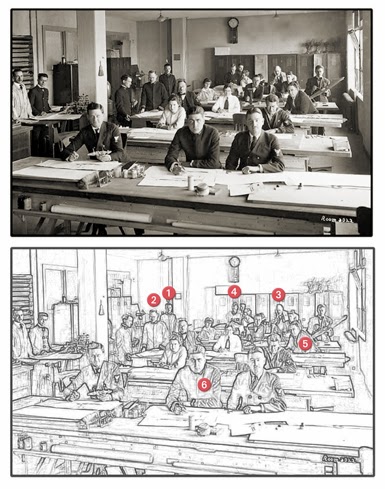 |
| US Navy camoufleurs (1918) |
 |
| Richardson (left) and Van Buskirk, looking at model and ship plans |
 |
| Richardson (?) and Van Buskirk in model storage room |
Below is more information about Raymond J. Richardson, with details regarding this unit. It is of additional interest that in 1922 Richardson was appointed Assistant Professor in the Department of Architecture at Carnegie Institute of Technology in Pittsburgh. The head of that school's Department of Art was Homer Saint-Gaudens, who had commanded the US Army's Camouflage Corps during WW1, and in 1924, Everett Warner also joined the faculty there.
•••
Anon, from SERVED IN CAMOUFLAGE SECTION OF U.S. NAVY. READING MAN UNDER WATER, ON LAND AND IN THE AIR in the Reading Eagle (Reading PA), April 11, 1919—
Ensign Raymond J. Richardson, of Reading, who, as a member of the US naval reserve forces, had been serving in the camouflage section of the navy, has been placed on inactive list and has returned to this home town to again take up architecture, the profession which he had been following when he left civilian life to answer the call to the colors. Ensign Richardson enlisted on July 10, 1917, at Newport RI, and was sent from that station to New York City, where he trained under William A. Mackay, considered the dean of naval camouflage in America. Mr. Mackay was at that time engaged in working out camouflage designs for the shipping board.
Later Ensign Richardson was transferred to the League Island Navy Yard, Philadelphia, and had charge of the camouflage work there. On February 25, 1918, he was sent to Washington, where he helped to organize the camouflage section of the navy. At first the designing department consisted of only three men [Van Buskirk, Warner and Richardson, presumably]. This finally grew until there were between 50 and 60 men.
Lieutenant Harold Van Buskirk, a well-known architect, was the executive head of the department, and Lieutenant Everett L. Warner, one of America's best landscape painters, was the head designer. Ensign Richardson served as assistant to these two men and had charge of the drafting room.
The work of this department was to design the type of camouflage which was to be used on the various vessels, both of the transport and combatant type. Models of the vessels were made in wood and these models were studied at various angles and ranges through periscopes and in this way the most effective type of camouflage was determined. Plans and blueprints were then prepared and these were used by the men in applying the camouflage.*
During the time that he was in the service, Ensign Richardson had occasion to make short cruises in submarines and also to make flights in airplanes in order to determine the effectiveness of the work of the camoufleurs. So he served under water, on land and in the air.
Among the men attached to Ensign Richardson's department at Washington was Earl Bankes* * , a brother of C.W. Bankes, of this city. Bankes was a warrant officer.
Ensign Richardson is a graduate of Reading High School, class of 1910, and of the University of Pennsylvania, class of 1913. He took a post graduate course at the latter institution and was awarded the degree of master of science in architecture in 1915.
After graduation Ensign Richardson worked in the offices of some of America's most prominent architects, principally in and about New York City. At present he is with E.Z. Scholl, a Reading architect.
Ensign Richardson is a son of Mr. and Mrs. Fred H. Richardson, 1324 Pricetown Road. His father is a member of the firm of Richardson and Early, wholesale confectioners.
* There were about 450 of these ship painting plans (reproduced in multiples as color lithographs), but apparently only two sets of the plans have survived. The most complete set is in the collection of Fleet Library at the Rhode Island School of Design (RISD), while a second set is housed at the National Archives and Record Administration (NARA).
** Through various online newspaper archives, we've located a number of articles on an Earl Bankes from Reading PA who had resettled in Miami FL, where his paintings were included in various art exhibitions.